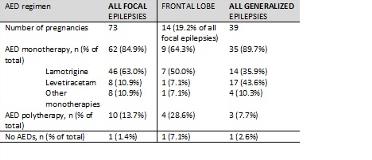Variations in Seizure Frequency During Pregnancy and Postpartum by Epilepsy Type
Abstract number :
3.236
Submission category :
4. Clinical Epilepsy / 4E. Women
Year :
2018
Submission ID :
507303
Source :
www.aesnet.org
Presentation date :
12/3/2018 1:55:12 PM
Published date :
Nov 5, 2018, 18:00 PM
Authors :
Paula Voinescu, Brigham and Women's Hospital, Harvard Medical School; Stephanie Allien, Brigham and Women's Hospital; Alexa Ehlert, Brigham and Women's Hospital, Harvard Medical School; Li Chen, Brigham and Women's Hospital; Emile Ansari, Brigham and Wome
Rationale: Prior studies suggest that seizure frequency (SzF) in the 9 months prior to pregnancy is a good predictor for the degree of seizure control during pregnancy, but less has been reported about the postpartum period. In addition, seizure worsening has been reported to happen more often in women with focal epilepsy, but a distinction among different localizations has not been made. We aimed to assess whether increased seizure frequency during pregnancy and postpartum period is more likely in women with focal or generalized epilepsy, and whether it differs by the localization of seizures. Methods: This study is an analysis of prospectively collected clinical data of pregnant women with epilepsy followed in the Epilepsy-Obstetrics Clinics at Brigham and Women’s Hospital 2013-2018. Exclusion criteria included abortions, seizure onset during pregnancy, poorly defined preconception SzF (“baseline”), non-epileptic seizures, AED non-compliance, and pregnancies enrolled in other studies (e.g., MONEAD). Seizure types and AED regimens were documented. We recorded SzF over 9-months preconception, during pregnancy and 9 months postpartum. All seizures for each individual were summed over each 9-month interval. SzF worsening during pregnancy or postpartum was defined as any increase above preconception SzF. Chi-square test of independence was used to evaluate differences between focal and generalized epilepsy, and between frontal lobe and other focal epilepsies. Results: Table 1 provides details of the 112 pregnancies included. Twelve patients had 2 pregnancies: 11 with focal epilepsy (3 with frontal lobe epilepsy and 8 with other focal epilepsies) and 1 with generalized epilepsy; and 1 patient with temporal lobe epilepsy had 3 pregnancies. 9-month postpartum data on SzF was available for 89 pregnancies (56 focal and 33 generalized). Patients with generalized epilepsies are more likely to maintain baseline seizure control during pregnancy, with increased SzF in 2.56% of pregnancies, compared to 21.92% with focal epilepsies (p=0.016). The gap narrows and reverses in the 9-month postpartum period with 7.14% of focal epilepsies and 12.12% of generalized epilepsies experiencing increased SzF above preconception baseline, but not significant (p=0.480). Compared to women with focal epilepsies of other localizations, women with frontal lobe epilepsy fared worse with increased SzF in 57.14% of pregnancies (p=0.0005) and in 18.18% during the 9-month postpartum period. Conclusions: This study found that women with focal epilepsy have higher rates of seizure worsening during pregnancy compared to women with generalized epilepsy, and women with frontal lobe epilepsy have especially elevated rates of seizure worsening during pregnancy and postpartum. Future analyses will evaluate the influence of AED type and concentration and specific timing on seizure control during pregnancy and the postpartum period. Future studies should also include measures of sleep, which may be a contributory mechanism to the differences found between these epilepsy types. Funding: P. Emanuela Voinescu receives support from the American Brain Foundation, American Epilepsy Society and Epilepsy Foundation through the Susan Spencer Clinical Research Fellowship. Alexa Ehlert receives support from the Karger Fund.
